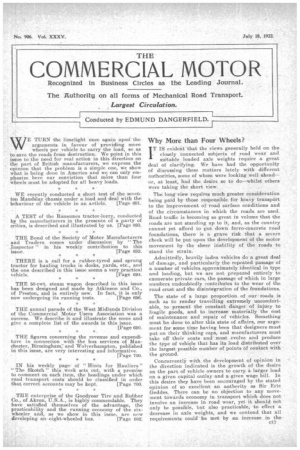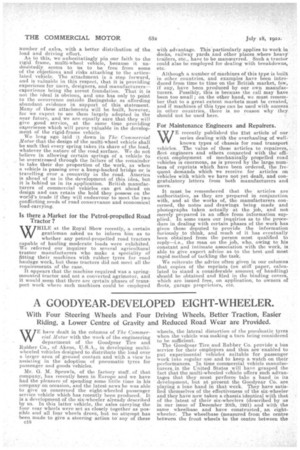Why More than Four Wheels?
Page 1

Page 2

If you've noticed an error in this article please click here to report it so we can fix it.
IT IS evident that the views generally held on the , closely connected subjects of road wear and suitable loaded axle weights require a great deal of clarifying. We have had the opportunity of discussing these matters lately with different authorities, some of whom were looking well ahead— or, at least, had the desire so to do—whilst others were taking the short view.
The long view requires much greater consideration being paid by those responsible for heavy transport to the improvement of road surface conditions and of the circumstances in which the roads are used. Road traffic is becoming so great in volume that the roads are not standing up to it, and, as the country cannot yet afford to put down ferro-conerete road foundations, there is a grave risk that a severe check will be put upon the development of the motor movement by the sheer inability of the roads to stand the strain.
Admittedly, heavily laden vehicles do a great deal of damage, and particularly the repeated passage of a number of vehicles approximately identical in type and loading, but we are not prepared entirely to exonerate private ears, the passage of which in large numbers undoubtedly contributes to the wear of the road crust and the disintegration of the foundations.
The state of a large proportion of our roads is such as to render travelling extremely uncomfortable, to present the constant danger of injury to fragile goods, and to increase materially the cost of maintenance and repair of vehicles. Something must be done to alter this state of affairs, our argument for some time having been that designers must put on their thinking caps, and manufacturers must take off their coats and must evolve and produce the type of vehiele that has its load distributed over the largest possible number of points of contact with the ground.
ConcurrentlY with the development of opinion in the direction indicated is the growth of the desire on the part of vehicle owners to carry a larger load on a given capital outlay and a given wage bill. In this desire they have been encouraged by the stated opinion of so excellent an authority as Sir Eric Geddes„ There can be no objection to any movement towards economy in transport which does not involve an increase in road wear, yet it should not only be possible, but also practicable, to effect a decrease in axle weights, and we contend that all requirements could bemet by an increase in the
number of axles, with a better distribution of the load and driving effort. As to this, we unhesitatingly pin our faith to the rigid frame, multi-wheel ' vehicle, because it undoubtedly seems to us to be free from some of the objections and risks attaching to the articulated vehicle, The attachment is a step forward, and is valuable in this respect, that it is providing experience for users, designers, and manufacturers-experience being the surest foundation. That it is not the ideal is obvious, and one has only to point to the occurrence outside Basingstoke as affording abundant evidence in support of this statement. Many of these attachments will be built, however, for we expect to see them largely adopted in the near future, and we are equally sure that they will give good service, at the same time providing experience which will prove valuable in the development of the rigid-frame vehicle.
We long ago laid it down in The Commercial Motor that the design of the multi-wheel vehicle shall be such that every spring takes its share of the load, whatever the nature of the road surface. We do not believe in allowing certain springs or a vehicle to be overstressed through the failure of the rent-Minder to take their due proportion of the work, as when a vehicle is passing over a hump-hacked bridge or is travelling over a• concavity in the road. America is ahead of us in the development of this idea, but it is behind us in its application. British manufacturers of commercial vehicles can get ahead on design and can retain the hold they possess on the world's trade if they will endeavour to meet the two _conflicting needs of road conservance and economical
coed-carrying. .
Is there a Market for the Petrol-propelled Road Tractor ?
WHILE at the Royal Show recently, a certain gentleman asked us to inform him as to whether any petrol-propelled road tractors. capable of hauling moderate loads were exhibited. We referred our inquirer to several agricultural tractor manufacturers who make a speciality of fitting their niachines with rubber tyres for road haulage work, but these tractors did not meet all the requirements of the ease.
It appears that the machine required was a springmounted tractor and not a converted agrimotor, and it would seem that there are certain phases of transport work where such machines could be employed with advantage. This particularly applies to work in docks, railway yards and other places .where heavy trailers, etc. have to be manceuvred. Such a tractor could also be employed for dealing with breakdowns, etc.
Although a number of machines of this type is built in other countries, and examples have been introduced from time to time on the British market, few, if any, have been produced by our own manufacturers. Possibly, this is because the call may have been too small ; on the other hand, we must remember that to a great extent markets must be created, and if machines of this type can be used with success in other countries, there is no reason why they should not be used here.
For Maintenance Engineers and Repairers.
WE recently published the 21st article of our series dealing with the overhauling of wellknown types of chassis for road transport vehicles. The value of these articles to repairers, fleet engineers and others connected with the efficient employment of mechanically propelled road vehicles is enormous, as is proved by the large numbers of reprints which have been ordered, the frequent demands which we receive for articles on vehicles with which we have not yet dealt, and congratulatory letters from both manufacturers and users.
It must be remembered that the articles are authoritative, as they are prepared in conjunction with, and at the works of, the manufacturers concerned, the notes and drawings being made and photographs taken actually at the job, and not merely prepared in an office from information supplied. In some eases our inquiries as to the procedure in dealing with certain phases of the work has given those deputed to provide the information furiously to think, and much of it has eventually been obtained from the person most qualified to reply—i.e., the man on the job, who, owing to his constant and intimate association with the work, is able to give expert advice as to the best and most rapid method of tackling the task. .
We reiterate the advice often given in our columns that copies of the reprints (on stiff paper, calculated to stand a considerable amount of handling) should be obtained and filed in the binding covers, which are issued free, on application, to owners of fleets, garage proprietors, etc.
































